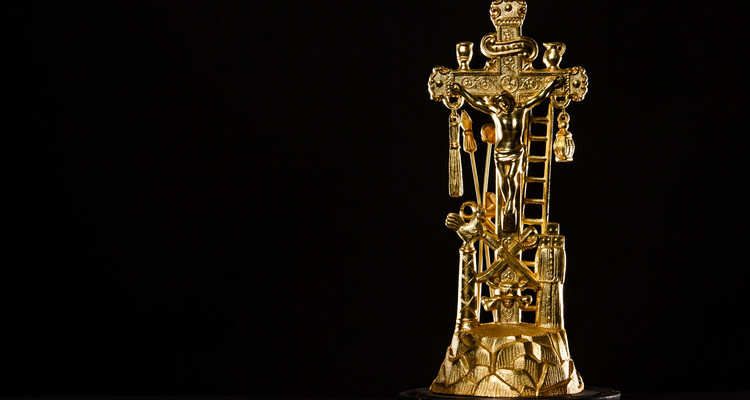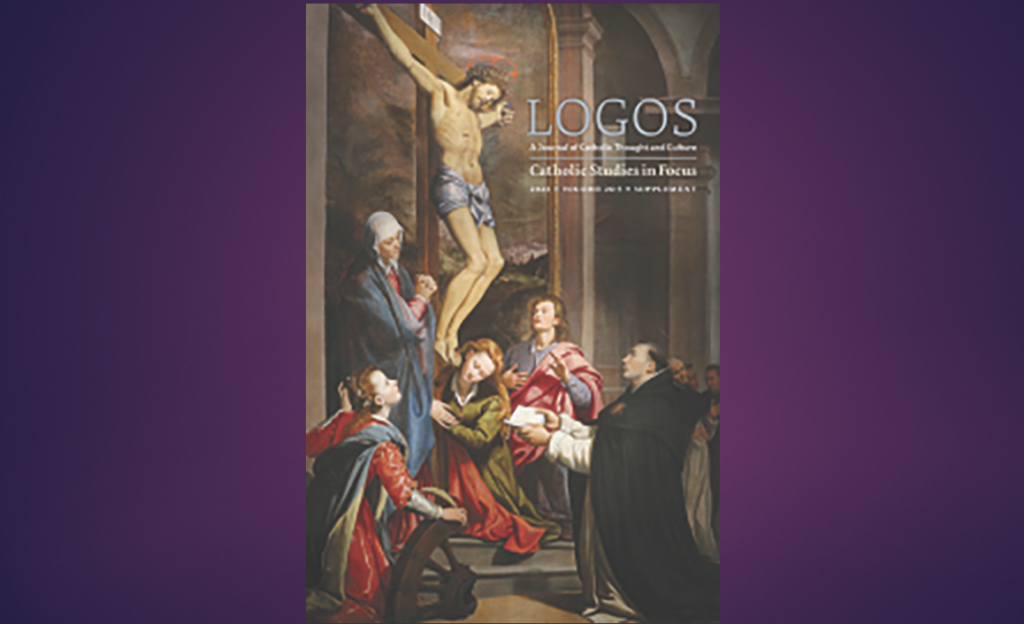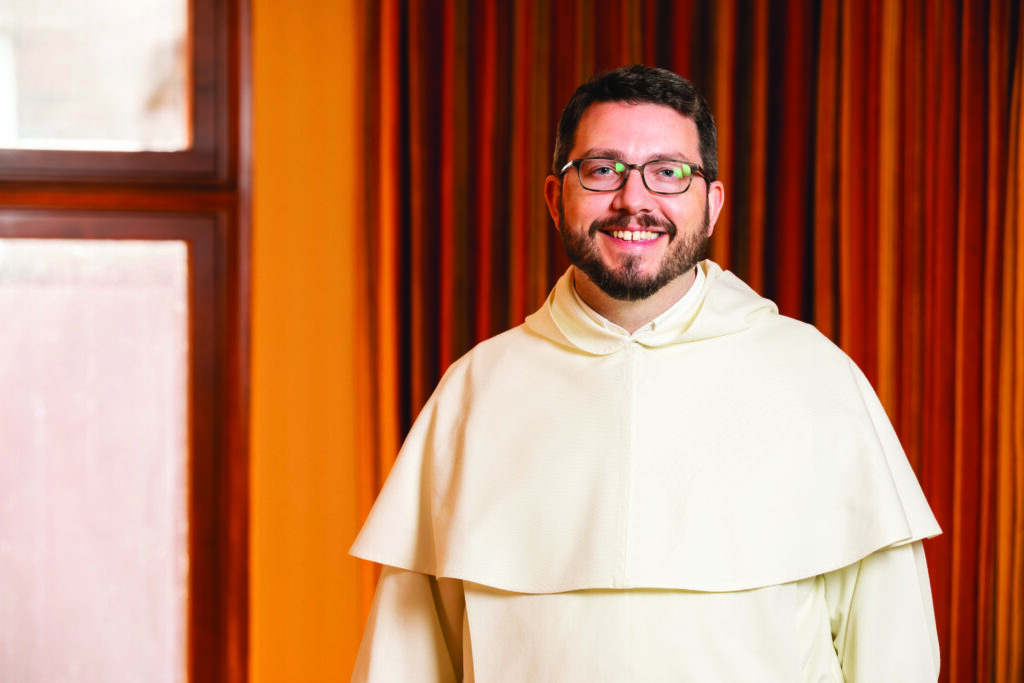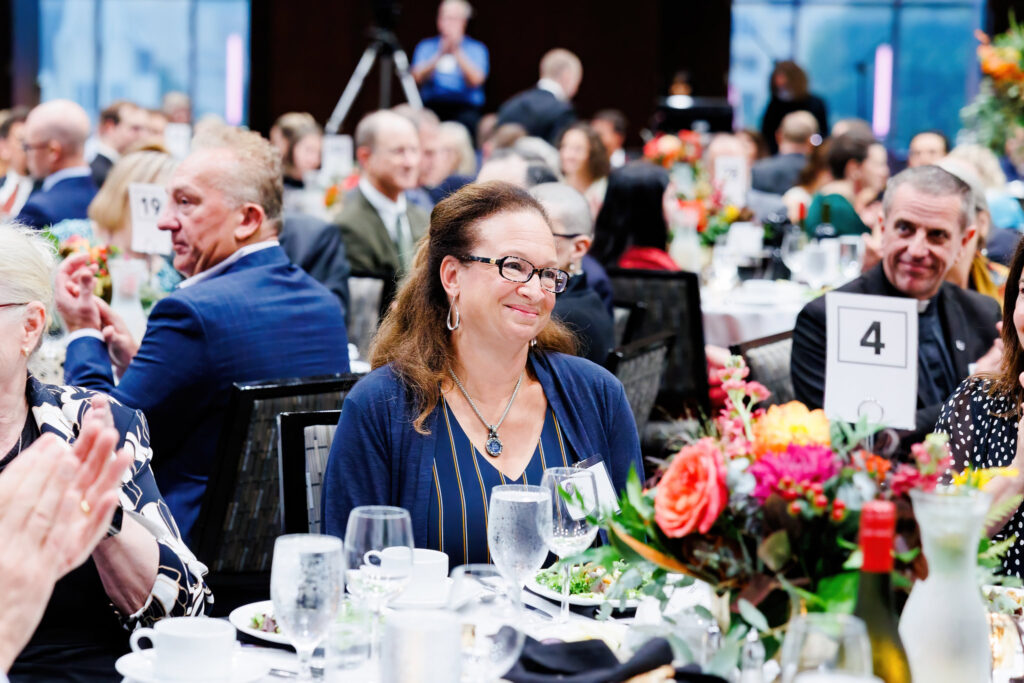In its seventh year, the Catholic studies graduate program’s Thought and Culture lecture series explores the dynamism and vitality of Catholicism and its impact on human thought and culture. This exploration is at the heart of the Catholic Studies intellectual project. This year the Master’s in Catholic Studies program partnered with the Department of Art History and Office for Mission to feature select pieces from the University of St. Thomas Father Dennis Dease Crucifix Collection, donated to St. Thomas in 2013.
The crucifix that hangs in our dining room is the largest in the house. Received as a gift, it’s a colorful piece adorned with four saints, but despite it being part of my daily landscape, I hadn’t considered its particular symbolism. I’ve admittedly thought of that crucifix as a simple expression of our faith: something to remind us of what we’re about, and to signal to guests ours is a Christian home.
But Father Jan Michael Joncas’ Feb. 6 Thought and Culture lecture compelled me to give it a second look. I discovered that it’s a replica of the Misericordia Crucifix, a 14th century Florentine, two-sided processional cross now in the holdings of the Metropolitan Museum of Art in New York. On the original, Christ is alive on one side and dead on the other – a theologically rich juxtaposition that wouldn’t have been lost to its original viewers, and shouldn’t have been lost to me.
Beware the ubiquity of the crucifix, I realized; it can render a powerful image banal.
In “Salve Sancta Crux,” or “Hail, O Holy Cross,” Joncas explored the art historical, anthropological and theological implications shaping the development of the crucifix over the centuries. He led up to an encounter with five crucifixes in the University of St. Thomas’ collection, which Father Dennis Dease gave the university before his 2013 retirement as St. Thomas’ longtime president. The collection’s 47 crucifixes range from the traditional to the unexpected.
The professor emeritus of Catholic studies and current artist-in-residence for the College of Arts and Sciences, Joncas observed that the first known depiction of Christ on the cross isn’t Christian art, but rather a mocking piece of graffiti that was discovered on Rome’s Palatine Hill. Known as the Alexamenos graffito, the image is of a man – likely Alexamenos, a Christian – gesturing to a crucified donkey-headed man. Inscribed next to the image is “Alexamenos worships his God.”
For early Christians, the cross was a form of “shame and horror,” Joncas said. It wasn’t embraced as Christian imagery before the legalization of Christianity, but it can be found as early as the fifth century as an icon of glory and triumph. These images don’t include the corpus, but foliage and gems. Called “crux gemmata,” this style is exemplified in the apse of Sant’Apollinare in Classe near Ravenna. In the center of a cross mosaicked with “gems,” an orb frames the face of Christ, presented as the Roman god Jupiter, king of all the gods, symbolizing his supremacy.
Early crucifixes showed not Christ crucified, but Christ glorified, alive and regally robed. These early Christian artists weren’t trying to show the crucifixion’s historicity, Joncas said, but its meaning – that Jesus has conquered death. The tradition of depicting the risen, reigning Christ on the cross continued in Eastern Orthodox iconography after the Great Schism, but the Western Church, influenced by the Franciscans, shifted to the contemplation of Jesus’ humanity and suffering and Christians connecting their sufferings to his. Christ was pictured near death or dead, sometimes with instruments of the crucifixion.
This style reached its zenith in works such as Matthias Grünewald’s Isenheim Altarpiece (1512-16), where the gruesomeness of crucifixion is on full display. The dead Christ’s skin is greenish and torn from whipping, his mouth agape, his fingers splayed heavenward. Joncas finds it jarring. “This figure, for me, is the strongest depiction of Christ suffering that the Western tradition ever developed,” he said.
With the Reformation in the 16th century, Protestants rejected Christian imagery as a primary means of coming to know God, preferring unmediated Scripture, and the crucifix became a symbol of Catholicism itself.
Joncas presented this history – from the Roman graffiti to the Reformation – as a background to understanding Dease’s pieces, which postdate the Reformation. He introduced the collection with a 17th or 18th century altar crucifix from the Netherlands featuring an ivory corpus on wood with tortoise-shell inlay. Its design, Joncas observed, shows the interaction between a Baroque aesthetic and the Enlightenment, with sunrays around Christ’s head indicating his glory, and the geometric base perhaps symbolizing the “kind of order that the triumph of Christ brings about.”
Others from the collection were an 18th century Portuguese crucifix; a 19th century French house altar with tiny instruments of the crucifixion; and a 20th century Celtic sun-wheel cross constructed in peat.

Artwork being displayed while Father Jan Michael Joncas (background) speaks at the Catholic Thought and Culture Lecture. (Photo by Joseph Lavigne)
The final image Joncas showed was an abstract crucifix by Ellis Nelson, a metalworker from Muscoda, Wisconsin, who died in 2015. A stylized Christ formed by twisted steel is affixed to a simple cross, with spikes jutting up from the top of his spiralized “body” indicating his crown of thorns.
“For some of you, that’s going to look like the Alexamenos graffito that we began with, and you’re not going to be sure that this is worship of God. You might think it is blasphemy,” Joncas said. “Others will look at it and say, ‘No, this is clearly an act of an artist – a visionary artist – and faith.’”
Joncas explained early in his lecture that Scripture provides no description of what Christ’s crucifixion looked like. In recent centuries, historians have speculated on the mechanics of the crucifixion: the cross’ construction, which part of the cross Christ carried and where the nails pierced his limbs. The accepted facts of the crucifixion often contradict artistic representations, a situation Russian realist Nikolai Ge sought to rectify in 1892, with shocking results.
In traversing multiple levels of analysis for each of the dozen objects he presented, Joncas reminded his audience that a crucifix can be understood as a historical object, as an art form or as a picture of salvation. In an interview with me for The Catholic Spirit prior to the lecture, Joncas said he hoped audience members would leave with “a new and deeper understanding of the mystery of the crucifix.
“Art is subtle,” Joncas said. “It sometimes seizes the heart before the brain even knows.”
Maria Wiering Pedersen is the editor of The Catholic Spirit, newspaper of the Archdiocese of Saint Paul and Minneapolis.





